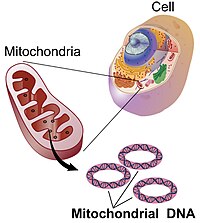
Photo from wikipedia
The Warburg effect suggests that upregulated glycolysis arising from high glucose uptake in cancer cells might be accompanied with suppressed mitochondrial respiration. However, recent studies have shown that the mitochondrial… Click to show full abstract
The Warburg effect suggests that upregulated glycolysis arising from high glucose uptake in cancer cells might be accompanied with suppressed mitochondrial respiration. However, recent studies have shown that the mitochondrial temperature in cancer cells could be relatively higher than that in normal cells, suggesting hyperactive mitochondrial respiration in cancer cells. However, hot mitochondria have not been reported in patients with cancer. Here, near-infrared small-molecule fluorescent probes TRNs are rationally designed with two ethyl amino groups as the temperature-sensitive moiety. Afterward, a mitochondrial targeting group is installed via ether bonds on TRN-8 to build MTN. To the best of our knowledge, MTN is the near-infrared probe with the highest sensitivity for mitochondrial temperature. Moreover, it also displays high photostability, wide linearity, and high specificity. Using MTN, we can monitor the ups and downs of mitochondrial temperature in cancer cells upon the perturbations of mitochondrial respiration. Furthermore, we demonstrate that the mitochondrial temperature in surgically resected human tumors is relatively higher than that in paracancerous tissues. Our results indicate that relatively hot mitochondria may exist in tumors from patients. We envisage that our study provides critical evidence for revisiting the Warburg effect and cancer metabolism.
Journal Title: ACS sensors
Year Published: 2022
Link to full text (if available)
Share on Social Media: Sign Up to like & get
recommendations!